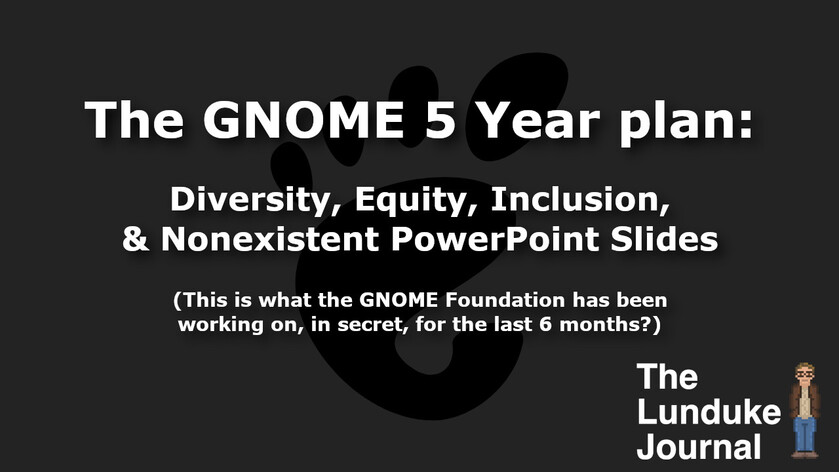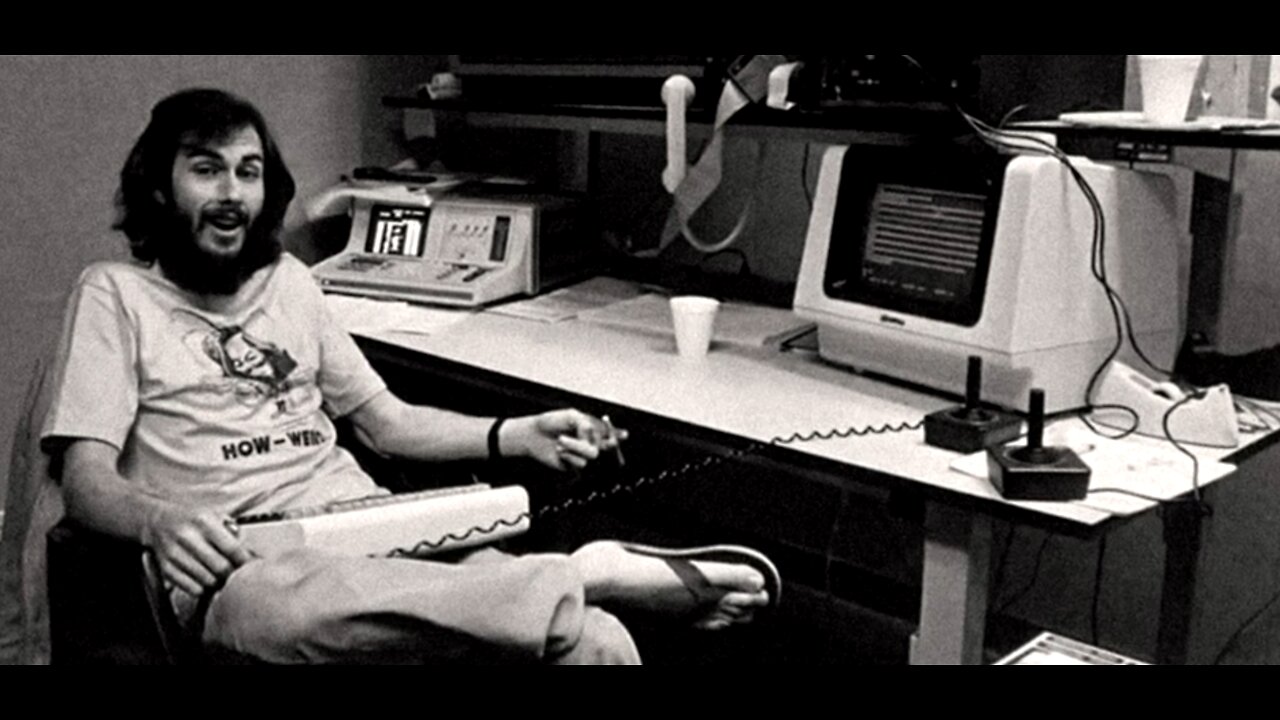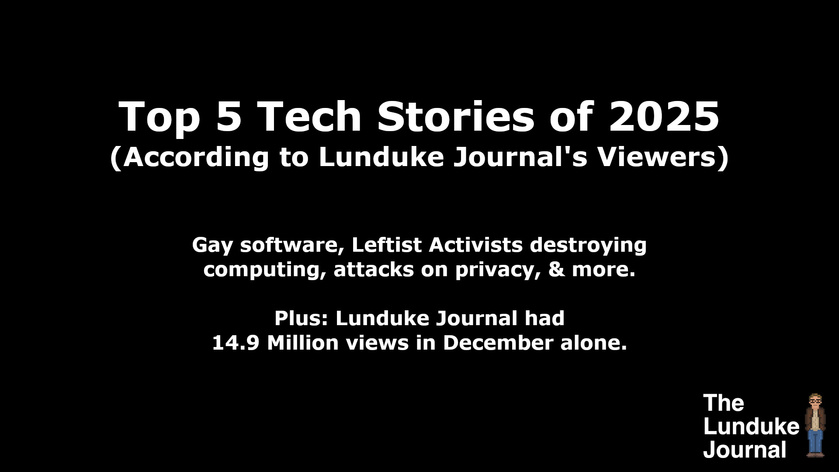The GNOME Foundation -- the organization behind the Desktop Environment used by nearly every Enterprise Linux company -- has had a pretty wild ride as of late.
First they hired a new Executive Director, who was previously a "Professional Shaman" (a fact they immediately worked to hide... which was... you know... weird). Then it becomes clear that they were in incredibly dire financial straits and needed to implement an emergency spending freeze.
No ifs, ands, or buts about it, the GNOME Foundation is having a rough go of it.
But, fear not! For the GNOME Foundation's Board of Directors has announced a draft of a glorioius "Five Year Strategic Plan", painstakingly designed to solve their financial woes and get GNOME back on the right track.
From their announcement:
"This draft was created over a six-month period through a process that involved research, individual interviews, and group discussions with staff, board, and members. This draft has been reviewed by the Board and is now ready to share with the greater community."
That's right. This plan took six months to create. Six. Months. Making it, assuredly, the most well researched, detailed, comprehensive plan in the history of Open Source Software!
Prepare to be Disappointed
I'll jump right to the point: This plan is neither detailed nor comprehensive. It is not a "took 6 months" plan... heck... it's not even a "took 6 hours" plan. It is, in fact, vague, poorly thought out, filled with DEI buzz words, and heavily reliant on wishy thinking.
The best thing I can say about this plan is that it is, thankfully, extremely short.
The GNOME Five Year Strategic Plan consists of just over 1,000 words and is broken up into three "Strategic Goals" sections:
- People
- Initiatives
- Capacity & Infrastructure
Let's go through the primary points of each section, shall we? I mean... it's short! So it won't take long!
(Note: The summarized points below are only slightly summarized, mostly to remove flowery, vague language... the entire, complete Five Year Strategic Plan contains very few additional details whatsoever.)
Goal One: People
Here we go. One bullet point at a time. With commentary and analysis on each.
- Take the voting board from seven to eleven members.
Ok. There are 7 board members. They want to add 4 more. Now there will be 11. How will that help GNOME? Who knows. But it's worth noting. Because it's one of the few times, in this whole plan, where actual numbers are mentioned.
- Create a more inclusive leadership model prioritizing advancing women, people of color, people from under-represented regions, and people with disabilities to positions of leadership.
Ah. Here we go. Right out of the gate. "Prioritizing" specific groups over others. Also known as discrimination.
How, exactly, does discriminating against some groups -- while falsely claiming "inclusivity" -- bring in additional funds (which GNOME desperately needs to stay operational)? Beats me!
- Communicate the social-benefit of GNOME by describing how GNOME directly empowers people, including under-served people.
Who, exactly, are these "under-served people"? Under-served... of what? Spaghetti? Have they been served too small a portion of spaghetti?
That's a joke. We know it's not referring to spaghetti. Or do we? This plan doesn't say what they're talking about at all. It might as well be all about spaghetti!
And what would the "social-benefit" be? You know... exactly. This plan doesn't say. Because that would be specific. And this plan is anything but specific. Or useful.
- Activate more diverse, under-served, female, transgender, and younger users and creators.
"Hey, how can we bring in a ton more money -- to bring our software development foundation back from the brink of bankruptcy?"
"Hmm. I dunno! Maybe say something about diversity? Oh! Throw in the word 'transgender'! That oughta do it!"
- Create GNOME Pathways Initiative (“Pathways”), an education program that recruits, mentors, educates, involves, and elevates as leaders new creators from Africa, Latin America, Asia.
Ok, here's an idea that actually has a little merit. Recruit people, in various locales, to work on GNOME related projects. Great. Do that. Why does this need to, specifically, be focused on "Africa, Latin America, and Asia"? That's not made clear in the plan. Maybe somebody really wants to take a trip to those areas?
It's also not clear how this would be done. Or what sort of specific, measurable goals this would have. Vague as vague can be.
But at least it's the beginning of a real idea.
- Launch a badging program — “powered by GNOME”
Right about now, you might be thinking, "Wait... they've worked on this for half a year... and they only have vague concept of creating a 'badging program' but haven't come up with anything else about it?"
Yup.
- Strategic partnerships with governments, universities, and nonprofit partners to reach new, under-served and diverse audiences.
Diverse! Under-served! Vague! Huzzah!
Goal Two: Initiatives
- Document all successes and impacts and incorporate all the new narrative into a refreshed GNOME Foundation website.
Ok. This actually seems reasonable. (Despite the structure of that sentence making my eyes bleed.)
Tell people all of the cool things GNOME has accomplished. Makes sense! That's the start of a marketing idea, right there!
... and it took the GNOME Foundation (and their new Executive Director) 6 months to simply come up with that idea. Shoot. Completing that entire task shouldn't take more than a small fraction of those "6 months".
What, exactly, has the GNOME Executive Director been doing for the last half year?
- Integrate fiscal sponsorship for Flathub apps and GNOME Circle apps
Integrate... fiscal sponsorship... for Flathub apps.
Huh. Ok. So... finding companies, or organizations, to become sponsors (read: advertisers) within software distributed via Flathub? Well. That's one possible way to raise funds.
Putting ads and sponsorships into software, though. That sounds very... Microsoft-y.
- Identify current critical security weaknesses in GNOME and fix them.
Wait. GNOME wasn't fixing security weaknesses already?
That... that can't be the case. Right?
- Create more documentation and tooling for GNOME as a whole; having these things will also fuel increased accessibility, diversity, equity, and inclusion for creators and users.
Diversity! Equity! Inclusion!
That'll definitely, magically, earn GNOME more money!
Wait. Documentation = increased Diversity, Equity, & Inclusion?
But. How? What? Trying to make sense of that is making my nose bleed.
- Create a more strategic, more inclusive, less expensive, more worldwide, and greener annual event for GNOME.
Remember when you were having a conversation with that software developer friend of yours, and he said, "Gee. I'd absolutely go to a GNOME conference... but they just aren't green or inclusive enough."?
But, hey, less expensive events! That seems like a good thing!
- Identify and market to new, outward-facing, under-served, and diverse audiences.
Oh, my gosh. Seriously? Again with the "under-served" and "diverse" mishegaas?
What in the heck does that mean, anyway? So if a new, potential GNOME user (or developer) isn't in whatever "diverse" group the GNOME Foundation randomly defines in the moment (because it's not called out in the "plan")... GNOME doesn't want them around?
What a weird -- and stupid -- thing to include in a plan.
Goal Three: Capacity & Infrastructure
- Document and claim in writing through a case for support and slide deck what we have already accomplished.
Read that sentence again. Say it out loud. Slowly.
Then remember that this sentence took 6 months to write. And was reviewed by the GNOME Board before being published.
Also... they didn't take 6 months to make a slide deck. They took 6 months to say "hey, we should make a slide deck some day".
- Quantify our impact in numbers through charts and graphs
"Hey, you know what successful Foundations have? Charts and graphs! Based on numbers! Let's come up with some of those!"
6 months to think of that... but not actually make any charts. Or graphs.
- Seek funding for GNOME Development
Six. Months. Just to think of the 5 words that sum up the entire, obvious reason why their foundation existed in the first place.
Seek funding for GNOME Development.
This is something that their Executive Director (and Board) should be doing. Every day. Constantly.
They just took half a year... to think about maybe doing it.
- Two or three crowdfunding campaigns each year for hard-to-fund meta activities to raise between $50K and $200K per initiative.
Great! How many crowdfunding campaigns has GNOME run in the last half year? Oh. Zero? But they want to have two or three per year? Better get busy.
Because, you know, GNOME is running out of money. Chop chop!
- Fundraise around becoming a Flathub sponsor; collect demographics for contributors in Github.
Wait. Collect demographics for contributors in GitHub? What in the heck does that mean, exactly? And how are those collected personal demographic details monetized?
This feels like something that's going to get GNOME yelled at.
- Develop direct funding relationships with at least twenty new foundations, at least 20 new corporate partners, and at least ten government agencies in 2024.
Ok. Great. Finally! A goal with an actual, measurable set of numbers on it!
How much of this has been accomplished in the last half year? Was it just thought about... or was it acted upon?
Will details on this be published so GNOME members and contributors can see how the Executive Director and Board are performing against these goals?
- Increase staff capacity by hiring (multiple new positions).
So... spend more money. Money GNOME does not have.
But will definitely have soon. Wink wink. Because of this totally sweet "Five Year Strategic Plan". Also... diversity.
That's it. Really.
And that brings us to the end of a complete analysis of nearly every point of this... ahem... plan.
A plan with an almost startling lack of details.
A plan primarily focused on repeating words like "diverse", "under-served", and "inclusive"... with very little focus on an actual strategy for keeping the GNOME Foundation afloat.
A plan that could have been written in a short afternoon. During commercial breaks while watching reruns of Scooby Doo.
In fact... this article contains more words than the entire "GNOME Five Year Strategic Plan". Seriously.
And, yes. I wrote this during commercial breaks... while watching reruns of Scooby Doo.



















